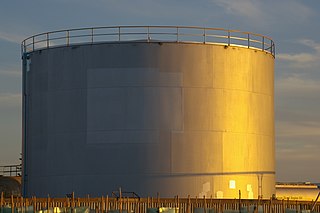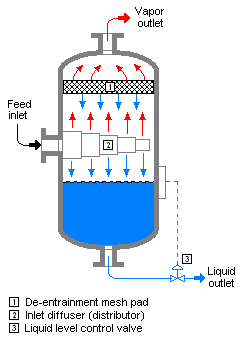
A heat pipe is a heat-transfer device that employs phase transition to transfer heat between two solid interfaces.

A chiller is a machine that removes heat from a liquid coolant via a vapor-compression, adsorption refrigeration, or absorption refrigeration cycles. This liquid can then be circulated through a heat exchanger to cool equipment, or another process stream. As a necessary by-product, refrigeration creates waste heat that must be exhausted to ambience, or for greater efficiency, recovered for heating purposes. Vapor compression chillers may use any of a number of different types of compressors. Most common today are the hermetic scroll, semi-hermetic screw, or centrifugal compressors. The condensing side of the chiller can be either air or water cooled. Even when liquid cooled, the chiller is often cooled by an induced or forced draft cooling tower. Absorption and adsorption chillers require a heat source to function.

A fuel tank is a safe container for flammable fluids, often gasoline or diesel fuel. Though any storage tank for fuel may be so called, the term is typically applied to part of an engine system in which the fuel is stored and propelled or released into an engine. Fuel tanks range in size and complexity from the small plastic tank of a butane lighter to the multi-chambered cryogenic Space Shuttle external tank.

A surface condenser is a water-cooled shell and tube heat exchanger installed to condense exhaust steam from a steam turbine in thermal power stations. These condensers are heat exchangers which convert steam from its gaseous to its liquid state at a pressure below atmospheric pressure. Where cooling water is in short supply, an air-cooled condenser is often used. An air-cooled condenser is however, significantly more expensive and cannot achieve as low a steam turbine exhaust pressure as a water-cooled surface condenser.

An oil terminal is an industrial facility for the storage of oil, petroleum and petrochemical products, and from which these products are transported to end users or other storage facilities. An oil terminal typically has a variety of above or below ground tankage; facilities for inter-tank transfer; pumping facilities; loading gantries for filling road tankers or barges; ship loading/unloading equipment at marine terminals; and pipeline connections.

Vaporrecovery is the process of collecting the vapors of gasoline and other fuels, so that they do not escape into the atmosphere. This is often done at filling stations, to reduce noxious and potentially explosive fumes and pollution.

The AP 42 Compilation of Air Pollutant Emission Factors is a compilation of the US Environmental Protection Agency (EPA)'s emission factor information on air pollution, first published in 1968. As of 2018, the last edition is the 5th from 2010.
In the upstream oil industry, a gas–oil separation plant (GOSP) is temporary or permanent facilities that separate wellhead fluids into constituent vapor (gas) and liquid components.

Storage tanks are containers that hold liquids, compressed gases or mediums used for the short- or long-term storage of heat or cold. The term can be used for reservoirs, and for manufactured containers. The usage of the word tank for reservoirs is uncommon in American English but is moderately common in British English. In other countries, the term tends to refer only to artificial containers.

An evaporator is a device used to turn a liquid into a gas.
An oil production plant is a facility which processes production fluids from oil wells in order to separate out key components and prepare them for export. Typical oil well production fluids are a mixture of oil, gas and produced water. An oil production plant is distinct from an oil depot, which does not have processing facilities.
Onshore, when used in relation to hydrocarbons, refers to an oil, natural gas or condensate field that is under the land or to activities or operations carried out in relation to such a field.

In chemical engineering, a vapor–liquid separator is a device used to separate a vapor–liquid mixture into its constituent phases. It can be a vertical or horizontal vessel, and can act as a 2-phase or 3-phase separator.
Offshore concrete structures, or concrete offshore structures, are structures built from reinforced concrete for use in the offshore marine environment. They serve the same purpose as their steel counterparts in oil and gas production and storage. The first concrete oil platform was installed in the North Sea in the Ekofisk oil field in 1973 by Phillips Petroleum, and they have become a significant part of the marine construction industry. Since then at least 47 major concrete offshore structures have been built.
A loading arm permits the transfer of liquid or liquefied gas from one tank to another through an articulated pipe system consisting of rigid piping and swivel joints to obtain flexibility.

Pumpable icetechnology (PIT) uses thin liquids, with the cooling capacity of ice. Pumpable ice is typically a slurry of ice crystals or particles ranging from 5 micrometers to 1 cm in diameter and transported in brine, seawater, food liquid, or gas bubbles of air, ozone, or carbon dioxide.
A volatile corrosion inhibitor (VCI) is a material that protects metals from corrosion. Corrosion inhibitors are chemical compounds that can decrease the corrosion rate of a material, typically a metal or an alloy. NACE International Standard TM0208 defines volatile corrosion inhibitor (VCI) as a chemical substance that acts to reduce corrosion by a combination of volatilization from a VCI material, vapor transport in the atmosphere of an enclosed environment, and condensation onto surface in the space, including absorption, dissolution, and hydrophobic effects on metal surfaces, where the rate of corrosion of metal surfaces is thereby inhibited. They also called vapor-phase inhibitors, vapor-phase corrosion inhibitors, and vapor-transported corrosion inhibitors.
A fixed roof tank is a type of storage tank, used to store liquids, consisting of a cone- or dome-shaped roof that is permanently affixed to a cylindrical shell. Newer storage tanks are typically fully welded and designed to be both liquid- and vapor-tight. Older tanks, however, are often riveted or bolted, and are not vapor tight. A breather valve, commonly installed on many fixed roof tanks, allows the tank to operate at a slight internal pressure or vacuum. This valve prevents the release of vapors during very small changes in temperature, barometric pressure, or liquid level. Fixed roof tanks without breather valves will generally be freely vented; thus the emissions from a fixed roof tank can be non-trivial. Gauge hatches, sample wells, float gauges, and roof manholes provide accessibility to these tanks, and also act as potential sources of volatile emissions.
A dry-seal Wiggins gasholder is a device designed to hold gas.

In an oil and gas production, flash-gas is a spontaneous vapor that is produced from the heating or depressurization of the extracted oil mixture during different phases of production. Flash evaporation, or flashing, is the process of volatile components suddenly vaporizing from their liquid state. This often happens during the transportation of petroleum products through pipelines and into vessels, such as when the stream from a common separation unit flows into an on-site atmospheric storage tank. Vessels that are used to intentionally “flash” a mixture of gas and saturated liquids are aptly named "flash drums." A type of vapor-liquid separator. A venting apparatus is used in these vessels to prevent damage due to increasing pressure, extreme cases of this are referred to as boiling liquid expanding vapor explosion (BLEVE).












